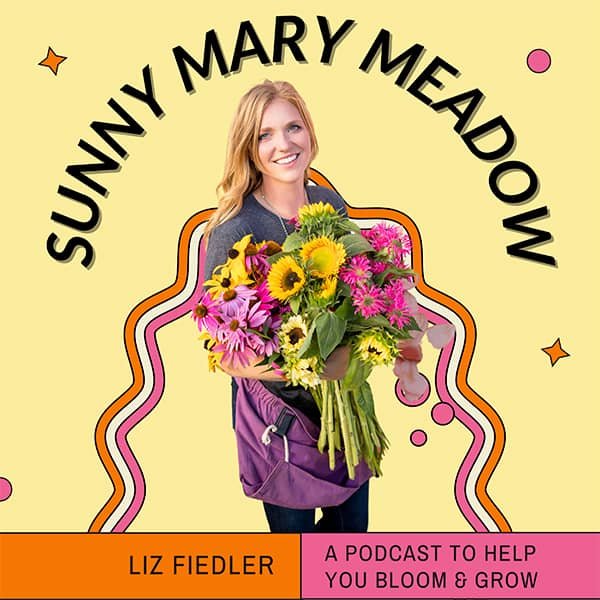
Hello! Welcome back to another post of the Sunny Mary Meadow blog. I’m your host/author Liz Fiedler and as always, thanks for being here.
Today, we are going to talk about growing in a small space and, ultimately, the term “succession farming.” A lot of people ask, “Oh, how many acres do you grow on?” They are shocked when I say somewhere between 1/4 and 1/2 of an acre. I produce a lot of bouquets – literally hundreds of bouquets a week.
That’s not a lot of space, and people are usually pretty shocked by that. Honestly, it takes a lot of planning, a lot of organization, timing things out, and knowing when things bloom. It’s pretty doable to do in a small space, and I think that, hopefully, you’ll listen to this and maybe tailor it to your backyard garden. If you only have a 20 x 20 garden, that’s a pretty good size to really incorporate a lot of these practices.
Ultimately, I have:
- One high tunnel right now that is 16 ft x 50 ft, which makes that 800 sq ft
- A space near the tunnel where I have a garden that is about 30 ft x 30 ft, which puts that at 900 sq ft (don’t worry, I will do the math for all of this for you at the end)
- My annual rows in my You-Pick area are 4 ft x 60 ft, and I have 18 of those, so that’s just over 4,300 sq ft
- I have a small garden (well, it’s small to me) down by the road that’s, 30 ft x 50 feet, so 1,500 square feet. We are at a total of just over 7,500
- Where my perennials are, I have just over 4,000 sq ft broken down like this:
- Roughly another 15 ft x 65 ft of other perennials, so another 525 sq ft there
- Six rows of peonies that are 120 ft x 5 ft, so roughly 3,600 sq ft
An acre is roughly 43,000 sq ft, and I grow on just under 12,000 sq ft, so just over 1/4 of an acre.

That might sound crazy, but I make it work by having the plan to use that space very wisely. I do plan on potentially, even as early as this spring, adding another high tunnel that’s 100 ft x 16 ft. This is mainly because I’ll need more flowers in the fall for my wedding, so obviously, I need another high tunnel to extend my season, but we’ll get to that later. Even if I do that, it’s still only another 1,600 sq ft, so still closer to 1/4 of an acre than 1/2 of an acre. So, when I plan everything out, ultimately, I try to plant a lot of different flowers that are going to be blooming at different times, and then figure out their days to maturity or when they’re blooming, and then I can plant multiple things in the same spot.

There are three types of flower categories that I kind of look at. The first one is considered “cut and come again.” I use that term a lot in my You-Pick areas, where the more you cut them, the more you grow or, the more that they produce. I talked about this in an earlier post about when the ice cream truck was here with the little kids, and they were cutting my zinnias, and they ended up really trampling them. That zinnia plant’s job is to produce another plant. That’s its only job – to continue living by going to seed and producing another plant. So, if you cut off one of their stems, it signals the plant to make another one, and then it makes another bloom. With plants like zinnias, cosmos, and marigolds, for example, the more you cut them, the more they produce.
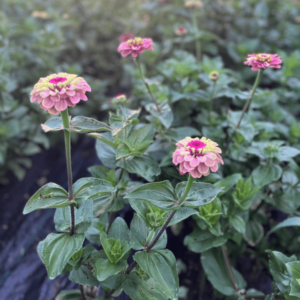
Then, there’s the category that I call “medium producers.” Snapdragons and lisianthus are probably the two that I really count on having what I call two flushes. With snapdragons, I usually get a big flush in late June to mid-July, and then once it gets really hot, they’re done for a while, but then in the fall, I’ll get quite a few again. And then newer to me (I’ve grown them on a small scale, but I’m gonna have a lot of them this year) is lisianthus, and they’ll give you two flushes where you cut them, and then, later on, they’ll produce another one.
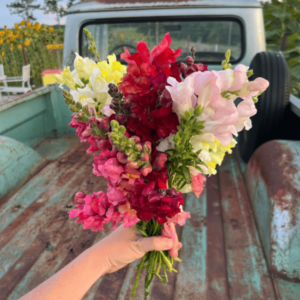
Lastly, we have what is called “one and done” (at least, that’s what I call them). These are the pro-cut sunflowers, bupleurum, stock, cress – plants that, once you cut them, they’re just done. For the most part, I try to do ones that are gonna bloom early. A lot of those that I mentioned bloom mid-June to mid-July for me, and then they’re done. So, what I’ll do is I’ll dig them out in July and then find something with short days to maturity growing period. Here that’s pretty much sunflowers. The pro-cut variety that I do is somewhere around 50 days to maturity, so if I plant them by July 15th, I’ll be good. So, I dig up the stock when they are done blooming by late June, and then I just drop a bunch of sunflower seeds in their spot. So now I’ve harvested two flowers in the same spot. That same square footage takes up the same amount of space – the stock and the pro-cut sunflowers can both be planted in four-inch spacings, so it’s perfect. I just put them in the same hole.
Now, I want to talk about tulips. In my first year really growing tulips, I grew 1,000. Then last year, I had about 4,500, and this year I have 11,000. Again, tulips are going to have their own episode, but as cut flowers, they are planted as an annual – they are dug up, and then you throw them away. I know everyone thinks it’s crazy, everyone thinks it’s expensive, it’s wasteful, etc., but the thing is, if you try to replant the bulb, the plant needs to die back naturally, and then the bulb stores energy to produce another bloom next year. And if you do, it’ll be really tiny. Again, I’m growing them to cut and sell. So, my blooms need to be nice. Generally, pretty much all cut flower farmers do it that way. Plus, if you dig them up by the whole bulb, then you can plant something else in their place.
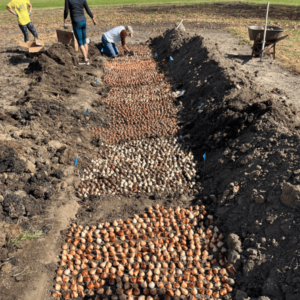
Of those 11,000, about half of them are in my high tunnel, and in normal years, they will probably bloom at the beginning of April or maybe even late March, but this year, our winter was really long, and they were later than that. This is my first year doing it this way, and it takes up about half of the tunnel right now, not even. So that half will be empty in April, and I’m gonna plant lisianthus in that spot then. The other half of the tunnel has ranunculus that I planted in early March. So, the lisianthus will go in the tulip spot, and that’ll be there for quite some time, and then once the ranunculus is done, I can put in some annuals that like the heat in their spot. So, that works out pretty well.
It’s the same thing with the other half of the tulips that are planted outside. I just ended up putting them in the You-Pick rows in the fall, and then maybe those rows will get planted later with something. Those aren’t going to be done until probably late May out in the field, but I can just reuse that spot over and over again.
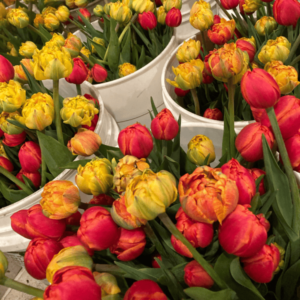
So those You-Pick rows, as I talked about, they’re 4 ft x 60 ft. If you do the 9-inch spacing, as I do for a lot of them, I can fit 320 plants. So, those 18 rows can each fit 320 plants. I would say, in general, every zinnia produces at least one stem a day during the big heat of it. So that’s 320 zinnias a day that I can pick from just one row. You can fit a lot of plants in a small area. And again, it’s not small, but 1/4 of an acre isn’t exactly huge when you’re thinking of the quantity that I’m growing. My small garden that’s like 30 ft x 50 ft used to be the vegetable garden when Josh was alive. I do something kind of interesting down there, but it works really well.
I’m going to talk about landscape fabric for weed barriers in its own episode, but essentially, I lay down this plastic that blocks the weeds. It’s black, so it heats the soil a little bit sooner in the spring. Then in the fall, I just cut down the plants and leave them there. In the spring, that soil warms up and can be tilled up and can be worked a lot sooner. All I do is remove the fabric, add some compost, stir it in, and put the fabric back on.

I use chicken manure. Well, in general, I use chicken manure in the fall, and I use cow manure in the spring, but I am making my own compost. Again, we’ll talk about that in its own episode. So usually, in mid-April, I’ll peel the landscape fabric back, put some cow manure on it, work it into the soil, and then I put the fabric back on it. Then I can plant some quick bloomers or flowers that can tolerate a frost pretty easily down there. Again, that’s the stock, the bupleurum, and the orlaya which are considered hardy annuals. They’re pretty much done by the time it starts to get warmer at the beginning of July, and then I can just stick some sunflowers down there. So that garden works really well to kind of time out when the ground is ready to be worked, essentially.
I also sow multiple sets of annuals for constant blooms. Once one is harvested, the next is ready. That is essentially what succession planting means. So, my pro-cut sunflowers, which I only get one out of, I plant them four inches apart. So every 10 days, I’ll plant about 250 of them, so then I just have this constant flush of them. Again, that’s why I said in an earlier post that people think a sunflower field would be pretty, but sunflowers on a cut flower farm aren’t necessarily that pretty. You pick them when they’re barely open, you can put them in the cooler, and then they last a long time.

Another huge benefit of succession planting is that it spreads out the work. When all Josh and I did was plant vegetables, it was like, “Okay, well, Memorial Day Weekend is when you got to get your garden in.” But if you time this out really well, for the amount and quantity that I’m doing, I can really divide up the planting side. I know what has to be done first, and every few days, I have to plant something, but it’s not like it all has to be done at once.
As I’ve talked about before, I’m in Zone 4, and we usually have a short growing season. It’s from May 15th to September 20th. So, in general, I’ll look at the days to maturity on the seed packet and just make sure that I’m gonna have enough time. I count backward basically from September 15th, and if it’s July 1st and it says 60 days to maturity, then okay, I’m good. But if it’s August 1st, it might end up with frost hitting it before I can even pick any flowers. Here in Minnesota (or at least in my area for the general cut flowers that we grow), we get a lot of spring flowers like tulips and daffodils, and then there’s a huge gap before everything else is ready. It’s usually like the week of July 4th or even a little later before the rest are ready. Usually, the week of July 4th, I’ve got enough sunflowers, snapdragons, and some orlaya left from what was in late June that I can make bouquets, and I can get that first week or two of subscriptions done, but I don’t have enough to sell to the general public because most stuff isn’t ready yet.
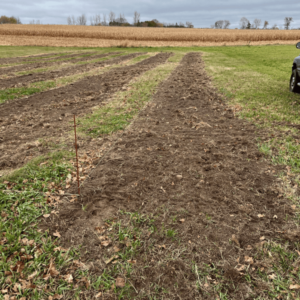
So, I’m really focusing on things that bloom in June. This year, I’ll have ranunculus, and then I’ll have the 500 peony plants. Hopefully, once they’re really established (you have to wait until they’re really established), but after that, they can live like 100 years. So, I’m really hoping that investment pays off because, trust me, it was an investment physically, financially, and emotionally (because they arrived late). I’ll do a whole episode on peonies eventually, but that’s what can hopefully really fill the gap.
It’s really fun to kind of experiment a little bit. As I said, I’m planting all these ranunculus in the high tunnel (we did a post about high tunnels recently, so if you haven’t read that yet, I recommend going back and doing that). I’m going to do two episodes/posts about ranunculus. I’m really excited to post them back-to-back around June when they bloom. We recorded an episode of the podcast now of what I think is going to happen and what I’m planning on, and then we’re gonna record one then to see what actually came of it. I know I’m gonna make some mistakes, and I’m probably planting way too many, but go big or go home. What’s the worst that can happen? They all die? Whatever.

My friend Ashley (who was part of the high tunnel episode/post) just posted the day I was recording this episode/post about how she “unalived” 3,000 plants in one day … literally unalived 3,000 plants in one day – and they’re ranunculus which is expensive. But that’s how you learn – you experiment and try things. She was like, “I got cocky, I don’t know what else to say.” I was like, “Sounds about right, cause I’ve got 1,800 of them coming … we’ll just see.”
I’m looking at experimenting. I may even try to maybe grow a couple of hundred ranunculus this fall because they have to bloom when it’s cool out, and that could be, you know, what I do in the second tunnel that I’m gonna build. I could plant some in trays in August and maybe get them blooming in the fall colors. Nobody in Minnesota has ranunculus in October or November, so it’s just really fun when you really start getting creative. Sometimes when you have that small space, you think, “How else could I do this differently?” So, you just get creative. People think I’m growing in this huge space, but really I’m not. I have another 23 acres of tillable land that I rent out. What I’m really contemplating is if there’s something cool I can do with it. You guys heard me talk about doing a sunflower maze, but again that’s only blooming for a couple of weeks. I don’t know, it would be fun just to turn it all to wildflowers, but I don’t know if I wanna do that … we’ll see. There are options – maybe I could throw 50 high tunnels on it and just grow ranunculus in the fall. I don’t know, we’ll see.
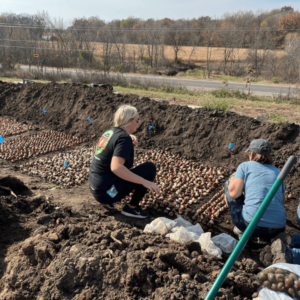
Other tips for growing flowers in a small space …
When it comes to flowers, you don’t really have to follow the packet, you can plant them a lot closer. Props to you if you heard the joke that I made in episode three about “9 inches is always better.” It was an accident, I really wasn’t trying to make that joke. But, seriously, 9-inch spacing for most of these plants does really well because they reach upward, and it saves space. Again, these are annuals that are going to die in the fall anyway, so we don’t really worry about diseases too much. The problem is that if they’re planted close together, they can’t always get airflow between them, and the bottom leaves start to rot. Yes, with your perennial plants, that’s a problem, but with your annuals, they’re going to die when the frost comes anyway, and it really doesn’t affect them.
You can also consider growing in pots or raised beds … they are lots of options. One other thing I’m considering doing to save space is growing lilies in crates (plastic crates), and then I can move them around. I could have them in a high tunnel all winter and then move them outside once it starts getting warm out. I could just put them on the concrete slab over by where the barn is, or I’ve got a huge, empty cattle feedlot when I could move them. I don’t know, just trying to manipulate where we can put things when growing in a small space. My lawn/yard is pretty big, but I don’t want just to dig it all up. I like having grass. So, get creative with the small space that you have.
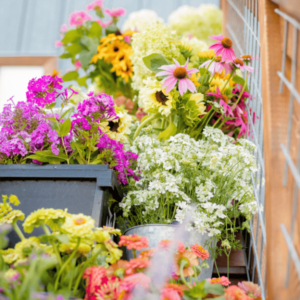
I’m gonna try to keep track of how many bouquets I sell from what I grow this year. So, I’m not counting Galentine‘s Day/Valentine’s Day flowers I bought for Easter from my wholesale distributor. I really want to see how many bouquets I sell from what I grow. On average, each bouquet has about 13-15 stems, so I’ll do that math and see how many stems I crank out for the summer. I’ll keep you guys updated at the end of the season.
Abbey:
Is it question time?
Liz:
It is question time, Abbey.
Abbey:
Coming off of your comment about curiosity about how many bouquets you’re gonna sell off of what you grow … a ballpark estimate? Just throw a number out there, and let’s just see if you’re close at the end of the year.
Liz:
All right, well, okay … I can’t do this without thinking out loud. So, I have like 1,400 subscriptions so far, if I sell more, it could be up to 2,000 of them (if I sell out of them). I’m about 2/3 of the way there, and I think I might sell out as summer gets closer and people see the pictures of them and stuff. So, let’s go with 2,000 bouquets there because it’s easy math. And I know I’m doing a stem bar every week at Rolling Ridge that goes from mid-May through mid-September. So, 14 weeks x 20 bouquets per week there. Then, I have my nursing home sponsorships that are already sold, and those are about 40 bouquets per week, so that’s another 400. I’m gonna guess I’ll probably clear 5,000 this summer. That’s A LOT of bouquets, but I don’t know; last year was about 3,000.
Abbey:
It’s insane to think that you’re doing this on less than 1/4 of an acre.

Liz:
Yeaahhh. So, year one was about 200 bouquets sold, but then for everyone, I did a buy one, get one for nursing homes, so that was like 400 that I made. And then, the next year, it was over 1,000 because I sold about five times as many from year one to year two, and then year two to year three, and last year was about 3,000. I figure with all of the stem bars and everything. Yeah, I bet we’ll clear 5,000 this year. I don’t know. Holy cow! Lindsey, if you’re listening, get your scissors and knife ready; we’ve got some stems to cut. I’m excited to see what that number is at the end of the year. Now, I have to keep accurate records.
Abbey:
Okay, next question … as you’re succession planting, and you say you plant like 250 sunflowers every 10 days? Is that what the numbers were? About how much work per week goes into succession planting?
Liz:
Oh man, so this year I’m really hoping to do, like, one day is for succession planting, one day is for weeding, I mean … just a few hours here and there. When I do succession planting, for the most part, I like it to be stuff where I can just pop seeds in the ground. I don’t really mess around with succession planting big trays of flowers. If I have to start a seed, where it might not do great if you start it right in the ground, you know … starting it in the tray first, letting it grow for four weeks, watering it, keeping it alive, and then putting it in the field, it’s just a lot of time. So, I don’t usually do second successions of stuff like that. A lot of flower farmers across the U.S. do a second succession planting of things like snapdragons, but here we have such a short growing season, and we don’t really have much of a spring. It just goes from cold to hot very quickly. It’s not like we have this five-month spring like other places have, so I just don’t mess around with it. And I think most Zone 4 farmers don’t do that. So yeah, I would say I try just to be mindful of keeping it as limited as possible.
Abbey:
Okay, then the last question I have … so when you are working with less than 1/4 of an acre of field, do you separate all of your different fields by “cut and come again,” “the medium one,” and “the one and done?” Are they all in their own field? Or do you mix them up together?

Liz:
So, I think maybe we talked about this in one of the earlier posts, but what I really try to do is … in that You-Pick area, those are “cut and come again” because those are flowers that if someone accidentally cuts one, I don’t wanna get upset. I don’t want to have to babysit, and I want everyone to have a good time. I don’t wanna have to say, “This row, this row, and this row are off limits, but the rest you can do.” I try just to keep the more needy plants farther away from that area, and then maybe I’ll cut a bucket of them, and they can buy them a la carte, or maybe a few are included with the You-Pick. I haven’t decided. Honestly, I’ll probably just leave it up to my customers and be like, okay, this is roughly what I know that I need. You know, I think most customers are willing to pay a few dollars more for the bouquet that they want. And if you’re like, “You get one or two sunflowers,” and if they’re like, “I just want to pick some sunflowers, and I don’t care if it’s another X amount of dollars,” then okay, sweet.
Abbey:
Alright, that’s all for questions.
Liz:
Awesome, well, thank you.
Thanks for listening to/reading the Sunny Mary Meadow podcast/blog. I’m your host, Liz. If you like what you’re hearing/reading, please subscribe and rate us. You can also find us on Instagram, Pinterest, and Facebook.
You can subscribe to our email newsletter below. We love to hear any podcast-related feedback at our email podcast@sunnymarymeadow.com, and all other inquiries can be sent to liz@sunnymarymeadow.com.
